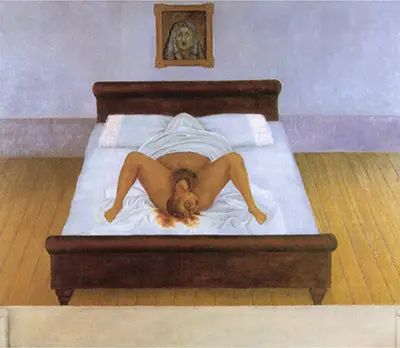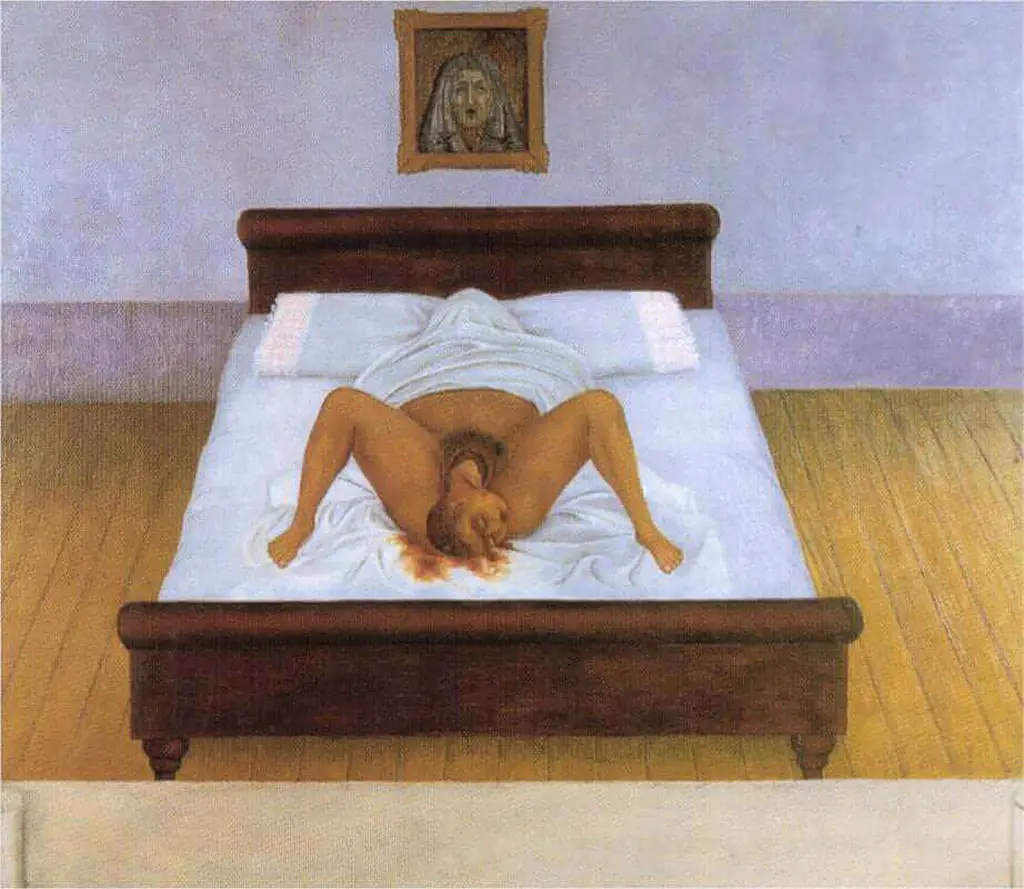The woman is Kahlo's mother, although we cannot see her face in the paining, as it is somewhat bizarrely covered by a white bed sheet. It was Kahlo's husband who encouraged her to paint the events of her life that were of the most importance to her, and so this was one of her creations. The painting is indeed graphic and shows the birth of a baby. What is noted is that the baby's head is rather large, and looks to be much older than that of a newborn. What makes this image also more realistic is the bloodied bedsheets surrounding the mother, hinting at perhaps a traumatic birth.
This idea is further heightened with the fact that the mother is not observing the birth, as she is covered with a sheet, and that she is almost distancing herself from the event because it is too traumatic. My Birth, was also created not long after Kahlo suffered a miscarriage, and many believe that the painting represents her feelings and emotions about the loss of her own child. The painting was also created not long after the death of Kahlo's mother, so perhaps the covered face of the mother giving birth, is also a sign of respect for her recently deceased mother.
This sense of mourning is also portrayed with the painting that is hanging over the birthing bed, that of the Virgin of Sorrows, who observes the scene unfolding before her eyes, but she is powerless to do anything about it. She cannot help nor offer any words of encouragement. My Birth has very much divided the art community, with many art lovers choosing not to like the painting. The singer Madonna, however, adores the painting and uses it as a way to find out if the people in her life can truly be her friends. If they love the painting as much as she does, then they will be her friend for life. The artwork was sized at 14" wide x 12" tall.
It takes pride of place in Madonna's art collection. The famous singer is passionate about the career of Frida Kahlo and feels a connection with their respective roles in promoting the important role of women in society. Madonna went onto to purchase several other paintings from her career and has occasionally agreed to loan them out to international exhibitions. The levels of insurance required to loan such valuable artworks means that most galleries would not be able to finance such collections of work, even if they had got permission to do so. A large exhibition in the UK on Kahlo's career did manage to put a satisfactory package together, with the Tate having loaned other highly valuable pieces by artists previously, including Renaissance masters like Leonardo da Vinci and Michelangelo plus more modern painters such as Pablo Picasso and Vincent van Gogh.
The Broken Column, just as with My Birth, reduces detail to an absolute minimum in order to deliver a sombre atmosphere by leaving the subject looking lonely. The room found here has just one detail, a painting hanging above the bed, and nothing else. The Broken Column leaves Frida without any protection at all, other than a small sheet which covers her lower regions - the last piece of her that she still claims for herself. In the case of My Birth, perhaps the artist is portraying an image of modest beginnings, rather than any specific turmoil at this early point in her life. It was only later that several serious injuries and the unfaithful nature of her husband that Kahlo was to become truly damaged, physically and mentally. Two Fridas also offers another interesting insight into the mind of the artist.
This painting shows, "...how I imagined I was born."
Frida describing this work in her journals
It is believed that her husband, Diego Rivera, encouraged her to produce a series of paintings based on key moments in her life. This scene shows Frida giving birth to herself, hence her decision to leave her face covered by a sheet. She explained this personally, several years after the piece was completed. The blood found below the newborn may be a connection to Kahlo's recent miscarriage. The painting also came just after her mother's death - could that actually be the symbolic role of the sheet upon the woman's face? There is some evidence to support this, but she did also claim in her journals that she herself was giving birth to herself. Perhaps we should examine her other paintings in order to clarify the elements in this scene.


